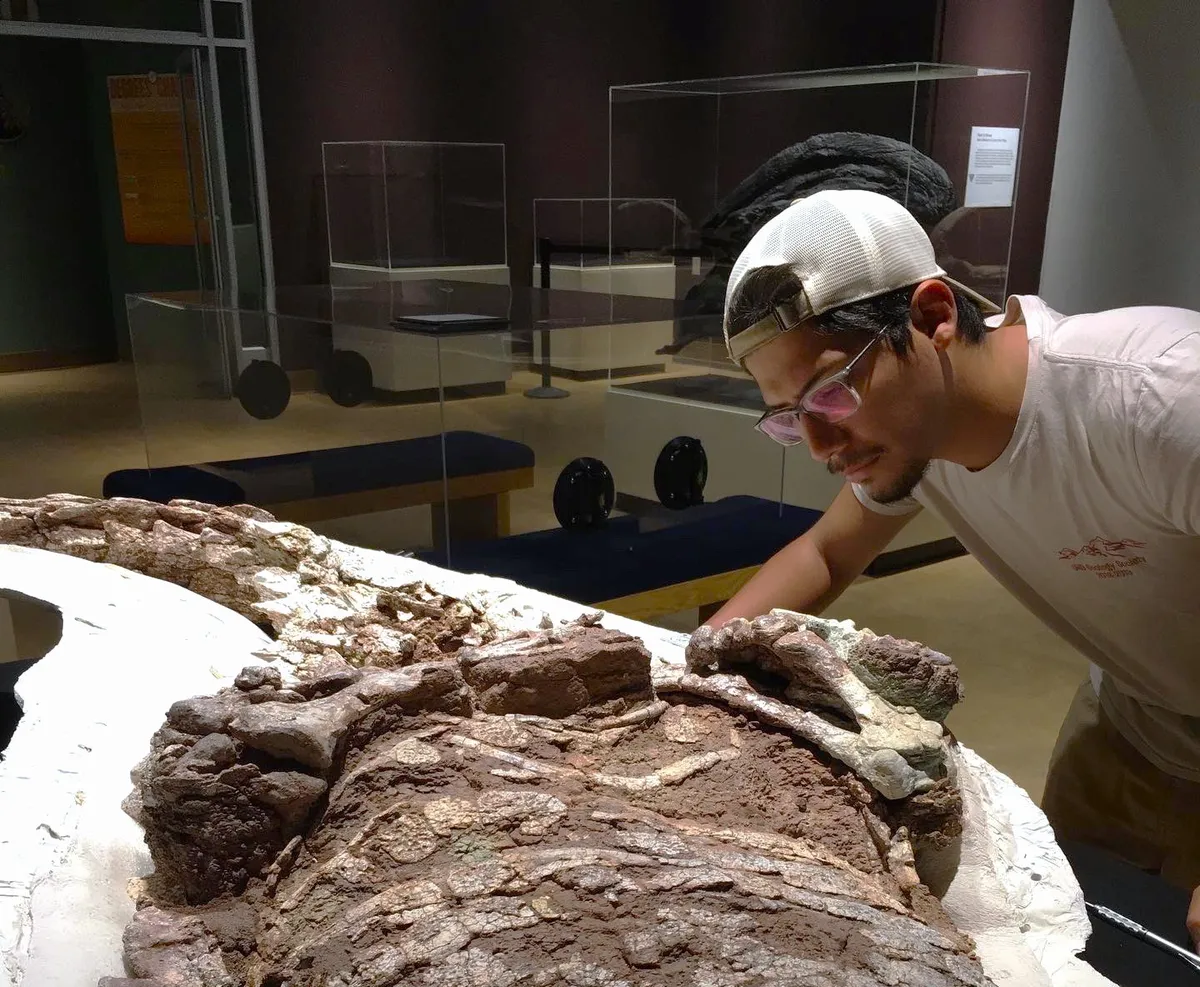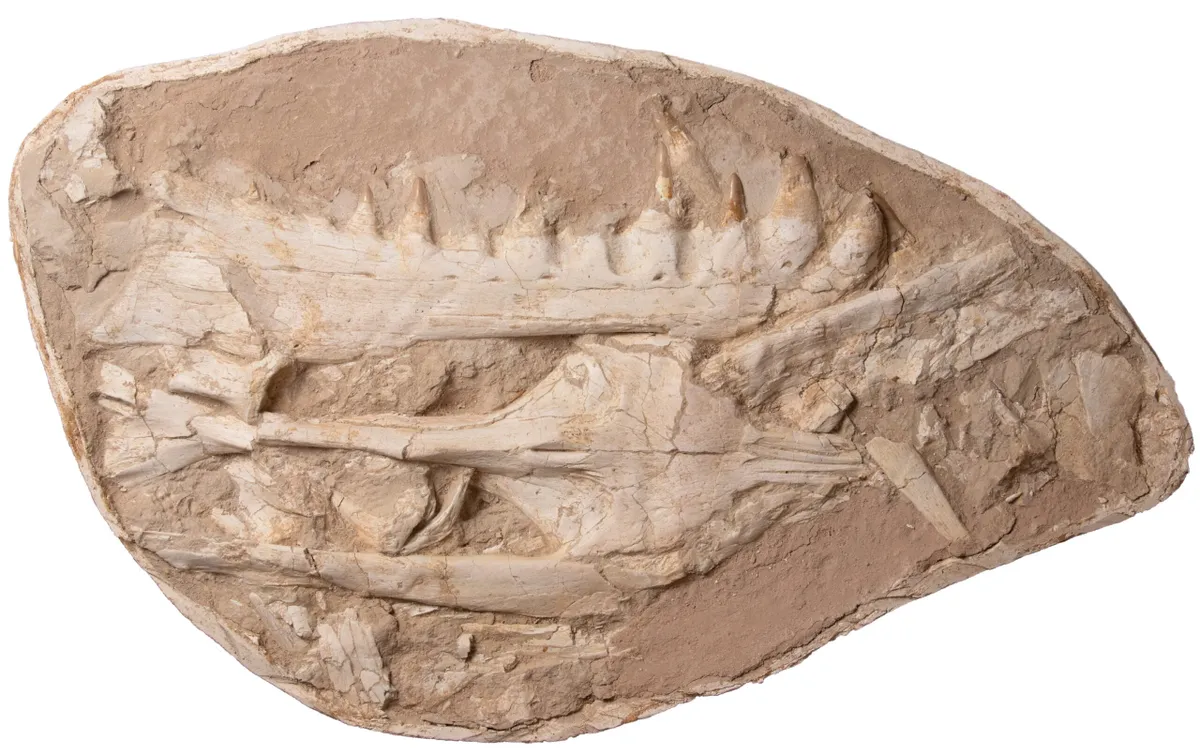What could be more exciting than digging up the remains of an ancient monster that once roamed the planet?
Already this year, scientists around the world have made some truly incredible prehistoric discoveries, from a giant salamander-like creature with a head shaped like a toilet seat to a half-a-billion-year-old slug that looks like a plastic bag. We take a look at 10 of the most epic prehistoric finds of 2024 so far.

10 astonishing prehistoric discoveries of 2024
Swamp monster with toilet-seat head dug up in Namibia

The remains of a giant salamander-like creature found on Namibia's Skeleton Coast were described as belonging to a new species – Gaiasia jennyae.
When alive, Gaiasia would have looked vaguely like a cross between a big salamander and a moray eel. It was huge for animals of its sort, probably approached four metres in length, and was entirely aquatic. Its body was long and flexible, and it likely had a deep tail fin like that of a gigantic newt. Its limbs are unknown, but the team suspect that these were tiny, and possibly absent altogether. Its head was broad and flat, with a squared-off snout, kind of like a toilet seat, according to the scientists who described the new species.
The discovery of this unusually large ‘stem-tetrapod’ sheds light on evolution in the cool south, long before the dinosaurs.
Mammoth tooth found in Vancouver Island playground

A piece of mammoth tooth found by a child in a playground on Vancouver Island has helped scientists create the clearest picture yet of when these huge prehistoric animals roamed the Pacific Coast island.
The specimen was one of more than 30 mammoth samples analysed in a new study, which suggests that the extinct Pleistocene mammals lived on Vancouver Island for much longer than was previously thought.
Largest snake to ever live discovered in an Indian mine

Scientists in India discovered the remains of an ancient snake species in a mine in Gujarat State, India. Later studies suggest that the new species may have reached lengths of up to 15 metres – that's longer than a bus.
The snake dates to the Middle Eocene period, approximately 47 million years ago, and would have been an ambush predator that constricted its prey to death, according to the experts.
Crocodile-like animal uncovered in Nevada

The remains of a new species of extinct crocodile relative were found in the rugged Favret Formation in Nevada's fossil-rich Augusta Mountains. "What the hell is this?" was the reaction of one scientist involved in the study that identified the new species of pseudosuchian archosaur – a group of living and extinct animals that includes modern crocodilians.
Described in a study published in Biology Letters, the discovery of Benggwigwishingasuchus eremicarminis reveals that while giant ichthyosaurs ruled the world's oceans during the Middle Triassic (247.2 to 237 million years ago), it was ancient pseudosuchian archosaurs that dominated the shores.
According to the scientists, the discovery rewrites the story of life along Earth's coasts during the Middle Triassic.
Giant worms found in Greenland

Scientists in North Greenland discovered the fossils of a new group of predatory worms more than half a billion years old that are totally new to science. The large worms may be among the earliest carnivorous animals to have colonised ancient seas, revealing a past dynasty of predators that scientists didn’t know existed.
Named Timorebestia, meaning ‘terror beasts’ in Latin, the worms had fins down the sides of their body, a distinct head with long antennae, massive jaw structures inside their mouth and grew to more than 30cm in length, making them some of the largest swimming animals at the time.
Colossal octopus-eating lizard unearthed in Australia

The fossilised remains of a prehistoric creature discovered in western Queensland in 2021 were identified as belonging to a new species of pterosaur, which lived around 100 million years ago and would have hunted fish and cephalopods. The formidable flying reptile, which lived alongside the dinosaurs, has been named Haliskia peterseni.
“With a wingspan of approximately 4.6 metres, Haliskia would have been a fearsome predator," says curator at the Kronosaurus Korner museum Kevin Petersen, who found the bones.
Half-a-billion-year-old slug from China

Scientists were thrilled to discover the fossils of a new species of extinct marine mollusc (Shishania aculeata) from eastern Yunnan Province in southern China. Dating from the early Cambrian period approximately 514 million years ago, the astonishing find reveals that the most primitive molluscs were flat, shell-less slugs covered in protective spiny armour.
Sea lizard with dagger-like teeth found in Morocco

Palaeontologists discovered the fossilised remains of an enormous new species of marine lizard in a phosphate mine south-east of Casablanca in Morroco.
According to the study, which analysed the skull and parts of the skeleton, Khinjaria acuta lived 66 million years ago, was 7-8 metres long – roughly the size of an orca – and had extremely powerful jaws with teeth like daggers. The findings suggest that our oceans were once far more predator-rich than they are today.
Giant dinosaur with 'bizarre' horns dug up in Montana

A new dinosaur with a colossal pair of blade-like spikes on the back of its frill was named from Montana. Lokiceratops rangiformis, one of the largest and most ornate horned dinosaurs ever found, is part of a rapidly evolving story that demonstrates strong region-specific evolution in this group of giant herbivores.
The new dinosaur is a ceratopsid – a four-legged, horned plant-eater akin to Triceratops – from 78 million years ago in the Late Cretaceous.
Largest marine reptile to ever live found in UK

Remnants of an enormous jawbone more than two metres long found on a beach in Somerset in south-west England were identified as a new species of giant ichthyosaur.
Experts believe the gigantic oceanic reptile would have been more than 25 metres long – as big as a blue whale, and lived during the Late Triassic period, more than 200 million years ago.
Giant crocodile with epic 'suit of armour' identified in Texas

After 30 years hidden away in a Texas university, the fossil of an aetosaur – a heavily armoured ancestor of modern crocodiles – was identified as a new species.
During a trip to Texas Tech University, William Reyes encountered the remains and decided to study them, eventually concluding that it was a new species. The animal was a heavily armoured cousin of modern crocodiles that ruled the world long before dinosaurs, and its discovery helps sheds light on the evolution of aetosaur armour.
Extinct walrus-like animal remains from England

Teeth found in Norwich (UK) and Antwerp (Belgium) were identified as belonging to a newly described species of extinct marine carnivore.
What’s particularly intriguing about the animal, which was named Ontocetus posti, is its similarity to the modern-day walrus. The unique combination of features on its mandibles is enough for the scientists to both describe it as a new species, and to suggest that it was able to suction-feed, like a walrus.
Dinosaur tracks uncovered in Alaska

Scientists in Alaska found a remarkable set of dinosaur tracks, fossilised plants and tree stumps in the far north-west of the American state. The discovery sheds new light on climate and movement of animals near the time when they began travelling between Asia and North America roughly 100 million years ago.
The find is particularly significant as it corresponds to the emergence of the Bering Land Bridge, an expanse of land that once connected the two continents, says the study.
New species of mini-ape identified in Germany

The partial remnants of two teeth and one patella of an ape species were dug up at Hammerschmiede clay pit in Bavaria, Germany. The size and shape of these remains are distinct from all other apes, said the scientist who studied the specimens, including Danuvius guggenmosi, a larger extinct species of great ape that lived in the same area 11.6 million years ago. Analysis suggests that the new species of great ape was tiny, weighing just 10kg.
More amazing stories from around the world
- Scientists stunned to find rare ocean bird that actually chases tropical cyclones
- Divers film surreal tuna crab swarm in California
- Prehistoric aurochs are back from extinction and spreading across Europe
- DNA confirms there IS a big cat roaming the British countryside
- 10 prehistoric mega-species that ruled before the dinosaurs

